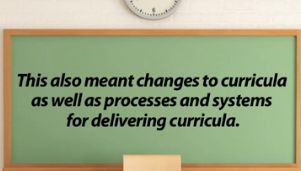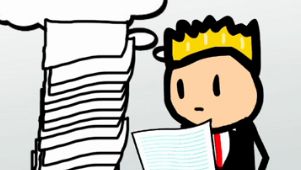Organizational Culture and Change
After you watch the video and know the material, click HERE for the quiz.
Organizational change involving altering processes and systems within a company often affects the existing group norms, beliefs and values. This makes change a challenge for managers. There are tactics managers can use to institute change in a positive and welcoming way.
Organizational Culture and Change
People say change is good! Change can be a good thing when it is done holistically, taking the whole organization into consideration - including processes and systems and the culture of the organization - equally.
In most American homes, the Thanksgiving table is set with turkey, stuffing and pie. It's always been that way. It's tradition! Suppose one year the turkey gets replaced with tofu, the stuffing with seaweed salad and the pie with goat milk, granola and berries? Families would be shocked and maybe even a little bit upset - particularly the older family members whose job it is to hold on to traditional values.
 |
When Mr. Winslow, president of Winslow Junior College (WJC), hired his nephew Buford, many of the staffers were worried that Buford was going to make waves. Buford was from a large, high-tech university. Staffers liked the way things were at WJC and didn't see a need to change a thing.
In Buford's first month, he made small changes to the dress code and the staff dining policy. No longer could the staff wear jeans or eat at their desks during class time. Buford's goal was to create a professional academic environment so that he could attract a new target market of students.
 |
Internal and External Change
Buford performed an analysis of the areas of the college that need change. He came up with changes in response to both internal and external factors.
There are two types of organizational changes that businesses endure:
- Internal change
- External change
Internal change involves changes within the organization's control, like processes and systems, human resources, decision-making, and policies and procedures. The organization has full control over these changes. These changes are generally initiated to increase productivity and profitability.
Internally, he knew the culture needed to be changed from a relaxed resort-type environment to a purely professional academic environment in order to attract new students. This also meant changes to curricula - and processes and systems for delivering curricula.
 |
Buford also needed to think about meeting the needs of the new student population. In order to attract a global student body, he will need to bring in new technology for online courses. Online courses require adhering to a much stricter financial aid policy for tracking student attendance. This meant training staff on both.
Everything at WJC was about to change. Buford's quandary: just how do I go about making changes without dismantling the positive things about the current culture?
Breaking the Resistance to Change
Buford spent much of his first month trying to figure things out on his own. President Winslow was no help - he was totally immersed in the current culture. Winslow was as relaxed as the rest of the staff and just as resistant to change.
 |
In order to gain a better understanding, he met with each department to discuss the impending changes. The outcome of the meetings was shocking! Buford found that staffers were resistant to change because:
- Staff acted in self-interest - change was not in their best interest
- Staff valued their current culture and saw no need to make a change
- Staff did not see a reason for creating additional processes or systems
- Staff did not trust the motive for change
- Staff did not fully understand the changes
- Staff was uncertain about their future after changes
Now that Buford knew why the staff was so resistant, he came up with a plan to facilitate change in the most participative way. He developed a process for change:
- Assess the need for changes
- Decide on the changes
- Implement the changes
- Evaluate the changes
Buford can assess the need for change by taking an inventory of the current processes and systems and comparing the outcomes with the organizational goals like higher enrollment, a more professional campus atmosphere and accountability to attendance regulations. He asked staff about their workload and elicited suggestions about improvements.
Once the assessment is complete, Buford will decide on the changes by evaluating the cost/benefit, time frame, projected outcome and other factors. He also evaluated the impact on staff motivation and satisfaction. Once the decisions are made, he will prioritize changes from the most important to the least important. This is not as easy as it sounds. Let's face it: in order for external changes to take place, the current culture must change.
 |
- Communicate and educate staff on the need for change by using strong examples of the current and the anticipated future conditions at WJC
- Involve staff in every step of decision-making, including a dress code, curriculum and online courses
- Negotiate changes so that the staff and management have balanced power
- Support staff through changes with training and rewards for their efforts
- Coerce resistant staffers to comply with change through promise of reward or threat of punishment
Once Buford was able to gain key allies in his war for change, others jumped on-board. Even old Winslow hung up his Hawaiian garb in exchange for a scholarly oxford and khakis.
Successful Change Strategies
It's been some time since the days of hot dog-eating math professors, and WJC is well on its way to becoming a respected professional college. Buford often reflects back to his early days.
 |
Buford was so impressed with the swift changes he was able to exact on WJC, he decided to write a book about his experience. In his book titled Successful Change - Old Dogs Learn New Tricks, he discussed several important factors for change. Change was urgent. He also talked about gathering a supportive group who would persuade others to change. His clear vision was disseminated. Small victories were celebrated and changes were made as needed.
These days, WJC is a leading online college with students from over 200 countries. As new staff is brought on, old staffers integrate them into the current culture of a forward-moving, academic institute of excellence.
Lesson Summary
In summary, when an organization sets out to make changes involving processes and systems, it often affects the existing group norms, beliefs and values, making change a challenge to managers. This is the organizational culture, or the combination of shared norms, beliefs and values that employees hold dear.
There are two areas of change an organization generally makes:
- Changes to the internal environment, like systems, processes, and policies and procedures
- Changes to the external environment - changes in political, social, technological or market conditions that drive change
Both internal and external changes affect the current culture for several reasons. The staff are self-interested, like the old ways of doing things, do not trust the change will be positive, do not understand the change fully and are uncertain about their future.
As the process of change takes place, it is important to work with staff so they are fully integrated into the plan and adapt quickly and seamlessly. At each step of the change process, management will need the support of key allies.
The change process involves assessing the need for changes, deciding on the change, implementing the changes and evaluating the changes. Once changes are planned, management can use several tactics to transition staff to a new environment. A wise manager would create a sense of urgency for change and form a support group who will spread the vision.